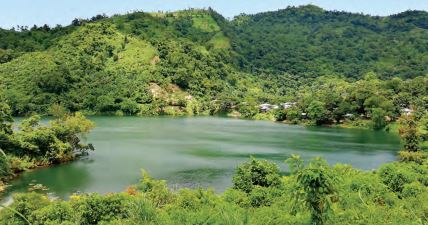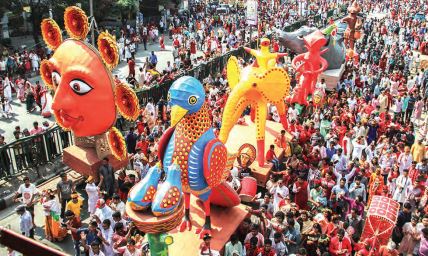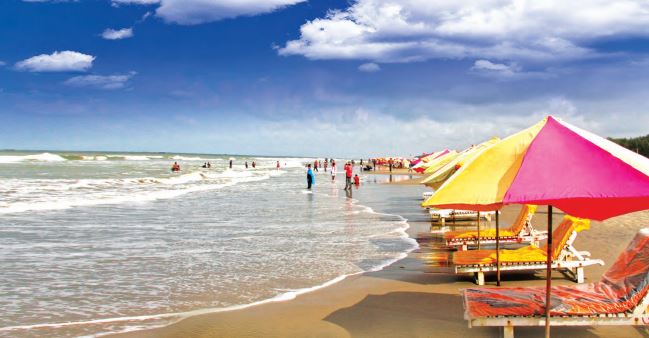
Bhubon Chandra Biswas, Chief executive officer, Bangladesh Tourism Board
To promote Bangladesh as an attractive tourism destination, the Bangladesh Tourism Board (BTB) is undergoing a complete makeover to mark its presence on the global tourism map. Bhubon Chandra Biswas, recently appointed CEO of the board, speaks to India Outbound.
Why would an Indian pick Bangladesh for holidaying?
Bangladesh is next door, less explored, cheaper in every sense, gifted with a tremendous variety of tourism products, both natural and man-made. Landscapes filled with lush green fields, seashores with long beaches, hills with scenic beauty, forests with flora and fauna, archaeological sites with tremendous heritage values, delicious food, centuries-old norms and values that make Indians feel at home at the same time give the experience of exploring a foreign country. On top of everything, the hospitable people will make their visit memorable.
Some of the most popular adventure travels in Bangladesh are offered through hiking the hills of Chittagong Hill Tracts, visiting the Chakma villages and the historical Buddhist Kyangs at the hill district of Bandarban, sailing across the river waters and spending time with a tribe, exploring the mangroves of the Sundarban where the forest is famous for its tigers, popularly known as the Royal Bengal Tiger as well as other animals such as spotted deer, wild boar, rhesus monkey, salt-water crocodiles, pythons, as well as many species of rare birds.

Boga Lake in the hill district of Bandarban, Chittagong Hill Tracts is famous for the local tribal village of Bawm
As a riverine country, river cruise plays an important part in the country’s tourism spread. One of the most fascinating cruises is the historic old paddlewheel service known as the Rocket Steamer. These paddlewheels were built in the British regime in the dockyards of Kolkata which are still playing a significant and historic role in the water travel of the country. Kaptai Lake, located in the hill district of Rangamati offers excellent opportunities for water sports. The lake is very good for sailing and swimming and anglers can enjoy fishing in the placid waters of the lake. Cruising by country boat on the river Sangu is another attraction for adventure seekers; Cox’s Bazaar is one of the most popular locations for modern water sports while the Sundarbans is ideal for boating and slow-sailing.
We are known for our warm hospitality and our people’s generous behaviour and great food. Our food is delightful; full of vegetarian and non-vegetarian varieties – a pure South Asian delicacy. The spectacular combination of our age-old traditional cooking style and a diverse range of perfectly blended spices give Bangladeshi cuisine a unique taste for which people from all over the world return to us. Shopping in Bangladesh, especially for garments is undoubtedly fantastic and very attractive to the Indian tourists in terms of quality and price.
What is your strategy this year to promote Bangladesh in India and beyond?
India, being our key source market, will always have our special attention and we have to formulate a focused strategy to generate more quality tourists in the coming days. We have a couple of important upcoming international tourism events to attend where we will try to understand what needs to be done to improve our branding and visibility of Bangladesh as a preferred destination for leisure, MICE and adventure. As far as India is concerned, we do have our focus on West Bengal and north-east. We also want to target a couple of other cities in India.

Mangal Shobhajatra, a mass procession that takes place at the dawn on the first day of the Bengali New Year was declared an intangible cultural heritage by UNESCO in 2016
We are doing better year on year. In the international market, we do get a decent number from the US, China, Japan, France, Spain, the UK, Russia and some of the other European countries.
Also, we have a very important upcoming event that is expected to generate huge interest among the Indian audience. From March 17, 2020 to March 17, 2021 Bangladesh will celebrate the birth centenary of the father of the nation, Bangabandhu Sheikh Mujibur Rahman. His legendary contribution to shaping our country will be celebrated with year-long programmes where we expect huge participation from India especially from Bengal. We are aware that Bangabandhu is seen in India also with very high regard. During this period, Bangladesh Tourism Board will undertake a number of tourism initiatives. This will surely generate a surge in tourism arrivals from India and we hope to celebrate the birth centenary of our founding father with our Indian brothers and sisters.
Since India is our biggest source market, we plan to do aggressive promotion in India and increase our presence in the coming days with a concrete plan. We would like to collaborate with more outbound tour operators, associations, and networking platforms, influencers and effective media resources to make the right impact in India and increase the number of quality tourists from India.
How important is the Bengali connection with India?
The Indian state of West Bengal and Bangladesh share the same language, though there are different dialects in the entire landscape, culture, cuisine root and a shared history. The north-eastern Indian states of Assam and Tripura also share a common culture and shared history, language and dialects. As people from Bangladesh love to visit West Bengal, and some parts of Tripura, Assam etc, I am sure feelings from the Indian side are also the same. In my years of interactions with the Indian tourists and other stakeholders, largely Bengalis, I can say with confidence that Bangladesh has a special place in their hearts. They will take every available opportunity to explore our country; we just need to present it in the best possible way.
And that is why Bengalis of India are our prime target at the moment. We connect with them. We consider each other brothers and sisters. The search of root for many Bengalis from India, keep a steady flow of travellers to Bangladesh. Also, there are people visiting friends and families. Very recently Bangladesh Tourism Board (BTB) endorsed an initiative called Chalo Bangladesh which connects Bengalis from both sides of the border speaking a common language in search of their origin, their root. We are going to continue to promote this initiative in India and expect a great flow of Bengali tourists coming in to attend one of the big festivals of ours, the Bengali New Year, Poila Boisakh in April, a World Heritage declared by UNESCO.
What is the current status of air connectivity between the two countries?
We have very good connectivity between India and Bangladesh, especially between Kolkata and Dhaka. You can travel in less than an hour and both the countries’ national carriers — Biman Bangladesh Airlines and Air India — fly on a daily basis. Other Bangladeshi carriers like Novo Air, US-Bangla, Regent Airways are also going full capacity nowadays in the sector. There is also a direct flight between Kolkata and Chittagong as well which is quite popular among the tourists and business travellers. There are other daily connections from New Delhi, Mumbai and Guwahati as well by other Indian carriers like Indigo and SpiceJet. There is scope for more low-cost flights between more destinations and I am sure we will get more routes opened in the near future.

Cox’s Bazar with its 120-km long unbroken beach is one of the most visited tourist destinations in Bangladesh
What do you have to say about border tourism with India which is connected through rail, bus and river?
Since the inception of our country Indo-Bangladeshi bilateral relations have been extremely deep and close and both the countries have stood by each other time and again. We share a major part of our border with India. If there is anything to be called border tourism, it is with India. Cross-border tourism is already there in some informal way, as you know we have very strong bus and train services that cross the border on a regular basis. Yes, we (both the countries) are yet to create an entertaining spectacle in the same line as Attari-Wagah border flag-lowering ceremony (on Indian border with Pakistan), which is enjoyed by the audience from both sides on a daily basis. But we sure have more interactive communication through cross-country car rallies, bike rallies, even cycle rallies, independent road trips etc., which strengthen nothing else but border tourism. We get feedback from tourists of both sides that they enjoy the train ride, the bus journey and now a new cruise route connecting India and Bangladesh. Connectivity beyond air route like these through land, road and water bring people closer and we have been witnessing this for years.
Getting a visa for Bangladesh from India is already a challenge, how are you planning to address the issue?
Due to heavy traffic at some of the deputy high commissions, we are aware of the inconveniences faced by the visa seekers. We are trying to streamline the process by making the process more online-friendly so that less time and effort would be required to obtain a Bangladeshi tourist or business visa. We are most concerned to ease the visa process in India as the demand is higher there. Since we want more MICE, adventure and luxury group tourists, we are also working on the process to ease the visa procedure of large groups.
What is the standard of hospitality outside Dhaka & Chittagong to attract high-end tourists?
As you know Dhaka and Chittagong can host any level of high-end tourists, other cities like Khulna, Sylhet and Bogura are also gearing up with good quality hotels, guest houses and resorts to host international tourists. In most of the top tourist destinations, Bangladesh Parjatan Corporation (BPC) has high quality official hotels, motels and guest houses in strategic locations with great cuisine services and other facilities.
How do you plan to compete with South East Asian countries in the Indian outbound tourism market?
I take this opportunity of your platform to clarify that we do not want to compete at all with our neighbours. We are aware of the great tourism growth that nations like Thailand, Nepal, Malaysia, Singapore, Bhutan, Sri Lanka have and we respect that. We would rather want very good co-ordination, cooperation and want to build a very good environment of regional collaboration with the goal of sustainable tourism in the region.
Tourism in the region is experiencing continued growth and diversification to become one of the fastest growing economic sectors in almost all these countries. Modern tourism is closely linked to the stakeholders of the industry at national, regional and international levels for sustainable development of tourism. Tourism creates jobs, attracts investments and drives infrastructure developments. Sustainable tourism can improve livelihoods, education levels and quality of life for local people as well. We know, if we work with a cooperative approach with our neighbours, if we refocus our energy and action towards conservation, preserve the cultural traditions and heritage, then the tourist numbers will automatically and gradually increase.
Visitors’ expenditures generate income for the local community and can lead to the alleviation of poverty in countries which are heavily reliant on tourism. Tourism provides financial support for the conservation of ecosystems and natural resource management, making the destination more authentic and desirable to visitors. Tourism can bring a real sense of pride and identity to communities. This is what Bangladesh Tourism is interested to work on as a shared vision with neighbouring countries.